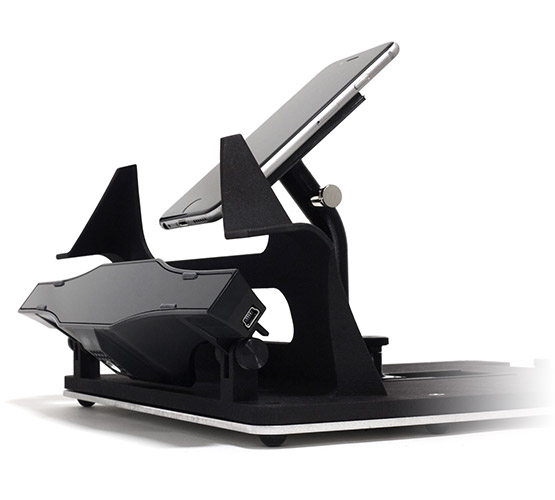We have created a state-of-the-art eye-tracking system that works specifically for mobile devices
Mobile devices have been technologically evolving, almost non-stop, for the last two decades. Every year, big tech giants make an effort to come up with a better device than the one that was released the year before, as well as trying to beat the competition. This competition brings more powerful hardware every year.
When we compare the latest mobile devices to any other device that we use daily, phones and tablets are not that far away from performing everything that a computer, a smart TV, and even a gaming console can do. This has made the market for mobile devices grow exponentially and it does not look like it’s going to stop anytime soon.
At Gazepoint, we are aware of the transition that’s been happening to these devices and we thought about offering a product that could handle the needs of researchers, designers, marketers, and everyone who is interested in improving the mobile world experience for the billions of users out there. We have created a state-of-the-art eye-tracking system that works specifically for mobile devices.

Here are some different fields of research where eye tracking systems have been of big help.
Market Research
Eye trackers have become an integral part of market research in the past few years. The data that these devices can provide often help with the way a company structures its physical and onlin e stores. The information that a study for marketing purposes yields can also be used to define physical aspects such as color, shapes, and other things that can be more interesting for the user to focus on it.
In a mobile device setting, the researcher can understand why the user looked a certain direction on the screen and modify their digital design to be able to cater or double down on the areas that were more attractive. This, in turn, can be used to expose products and more to increase sales.
Academia
In a mobile device setting, the researcher can understand why the user looked a certain direction on the screen and modify their digital design to be able to cater or double down on the areas that were more attractive. This, in turn, can be used to expose products and more to increase sales.
Medical Research
The medical field has benefited from the eye tracking systems by combining forces with other biosensors to help diagnose different diseases and disorders such as Autism Spectrum Disorder (ASD), Obsessive Compulsive Disorder (OCD), Attention Deficit Hyperactivity Disorder (ADHD), and others.
Gaming
The use of eye trackers has helped the gaming industry to understand more of their target audience and improve on design and playability. This has given an edge to the industry by creating more immersive experiences that push the boundaries of reality.
Simulations
Eye trackers have also helped many industries that rely on human feedback to keep growing. The automotive industry is one of them. The feedback from these systems has allowed the improvement of navigation, self-driving vehicles, and even the design of important parts of the interior such as the dashboard.
These are some of the most common uses of eye-tracking systems that we see in today’s world. There are other researches and developments that have experienced positive growth in their investigation thanks to the wonders of eye trackers and the important information they yield. If you wish to learn more about other uses and benefits of eye trackers, please feel free to contact us or read our blog!
Read Our BlogDesign
One of the things that can make or break your product is the way it looks. This does not necessarily have to be considered as the overall aesthetic appeal of the product but it does relate more to the design and reasoning behind having certain features, buttons, and other call-to-action items in certain places — the same items that ultimately will help you with your conversions.
Great design research done with an eye tracker for mobile devices can help you define major User Interface (UI) and User Experience (UX) elements that can improve the overall flow of what you are offering to your audience.
These are some of the results that can be considered from eye-tracking research to be applied to design:
- Visual Impact of CTAs: Can help you define if a certain color is better for
call-to-action items or if having these items in different locations would
yield better results. - Overall Visual Arrangement: Can help you learn more about the flow of
information and how the user is experiencing your product. - Time Spent: This aspect, coupled with the right questions, can help you
understand if your research subjects had a tough time going through
certain areas due to distractions.


User Experience
User Experience, commonly known as UX, is how your user goes through your product and ultimately defines if the product is a success or not. Design and UX can be tightly intertwined although they ultimately don’t have to drive each other.
Extensive research experience with multiple users can start creating visual patterns and attraction towards certain parts of your product and help you understand why those certain areas are more efficient at communicating the message that you are trying to give your users.
If you are able to combine a well-structured test for your research, ask the right questions, and make sure you are recording the eye movements of your user — which is something our Mobile Eye Tracking System offers— you can end up with thorough and comprehensive data which will serve you to improve your current version of the product or allow you to make the right changes to avoid user disappointment in the future.
A/B Testing
A/B Testing is something that’s practiced in almost every industry since it’s inherently a split test between two items. These items can be visual, physical, auditive, structural, or any other aspect that can define the improvement of your product.
The best part about being able to test different details or characteristics in your design, UX, UI, and other features of your product with eye trackers is that you receive more than one dimension in your data, and, with the right background for the study, you can revolutionize your own product and make it the best it can be.

What Can You Do With What’s Measured
There are over a hundred measures that can be determined by eye tracking. Some are simple to get and interpret, while others would need more extensive research and elaborated test design. Here are some of the most common unknowns that could be answered by using eye trackers for mobile devices.
Location
Location is everything! You can have the best and most attractive promotional image on the internet but, if it’s not well located on your mobile screen, you won’t be able to get good results from it. This is the reason why visual real estate is sold on certain platforms as advertising areas. Google’s top three or four spots in the results are usually sold as ads because they are the first things people’s eyes engage with when looking for something through the Google search engine.
At this point, the way we look at research through internet browsers can be determined by the years of conditioning we’ve had. That does not mean that for the product that you are creating, there’s already a predetermined area or section in the screen where you could benefit the most from placing what you need to expose. Eye trackers allow you to test different locations and conclude, after putting the data together, which is the best place to put advertisements, promos, or calls to action.
Desirability
Things like color, shape, and structure can define the appeal of an advertisement piece. There are psychological facts behind certain colors that can evoke different emotions and reactions in your users. Depending on the subject at hand, different colors can have somewhat of a similar reaction to what you are trying to accomplish.
If you run into a crossroad with advertisements because you don’t know which one will be more attractive to your consumers, you can use an eye-tracking test to figure out which option would work best for you and the product.
Interest
Directing people’s attention to where you want them to look is a powerful tool for selling specific products or services. With a good round of testing, you can get information on what type of design is more effective. If you are creating packaging for a product, you can rely on the data that an eye tracker can give you to make a final decision on the way your product is looked at.
Focus
There have been practices used by big streaming companies such as Netflix, Hulu, and other providers where they often change the cover of their products to attract different customers to watch certain shows or movies that the user was not previously aware of or simply not interested in.
This strategy can help increase your products’ exposure. If you have created a video that shows what your product can do, but your customer is more focused on the environment or background, or they are being distracted by an unimportant factor, it could cost you the conversion you were expecting. This is not because you don’t have the right product but because you might be taking too much attention off of what you are showcasing.


